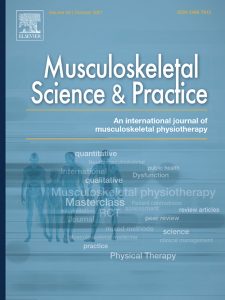Publications

Effects of dry needling on mechanical and contractile properties of the upper trapezius with latent myofascial trigger points: A randomized controlled trial
Authors: J. Sanchez-Infante 1, 2, A. Bravo-Sanchez 1, F. Jimenez 1, J. Abian-Vicen 1
Affiliations:
- Performance and Sport Rehabilitation Laboratory, Faculty of Sport Sciences, University of Castilla-La Mancha, Toledo, Spain
- Hospital Universitario de Toledo, Castilla La Mancha, Toledo, Spain
Journal: Musculoskeletal Science and Practice - September 2021, Volume 56, Article no. 102456 (DOI: 10.1016/j.msksp.2021.102456)
-
Field & Applications:
- Medical
- Complementary and Alternative Medicine
- Treatment evaluation
- Physiotherapy
- Musculoskeletal health
- Musculoskeletal rehabilitation
Background: Latent trigger point (LTrP) can cause motor dysfunction and disturb normal patterns of motor recruitment.
Objective: To analyze the effects of DN in the upper trapezius (UT) LTrP on pain and the mechanical and contractile properties of the muscle.
Design: A randomized, double-blinded, parallel-group-trial.
Methods: Fifty healthy volunteers with LTrPs in the UT were randomly divided into a DN-group (n = 26) and a Sham-DN-group (n = 24) and received one session of DN or placebo treatment. Mechanical and contractile properties of the muscle and pressure pain perception (PPP) were evaluated before treatment and in a 30min, 24 h and 72 h follow-up after treatment.
Results: In the mechanical properties, the DN-group showed lower values than the Sham-DN-group for dynamic stiffness at 72 h (p = 0.04). The DN-group showed lower values for dynamic stiffness at 72 h from baseline (278.74 ± 38.40 to 261.54 ± 33.64 N/m; p = 0.01) and for tone at 72 h from 30min (16.62 ± 1.27 to 15.88 ± 1.31 Hz; p = 0.01). In the contractile properties, the DN-group showed higher values for maximal radial displacement (Dm) of the muscle belly at 72 h from baseline (5.38 ± 1.67 to 6.13 ± 1.70 mm; p = 0.04), higher values for contraction time at 30min (28.53 ± 8.80 s; p = 0.03) and lower ones at 72 h (24.74 ± 4.36 s; p = 0.04) from baseline (26.97 ± 6.63 s). The DN-group showed a decrease of PPP from baseline to 72 h after treatment (5.16 ± 1.33 to 4.02 ± 0.97 mm; p < 0.01).
Conclusion: The application of DN in healthy volunteers over LTrPs in the UT decreased dynamic stiffness, tone and contraction time and increased Dm at 72 h after treatment. Additionally, the PPP showed a decrease at 72 h after needling.
Keywords: Myotonometry, Tensiomyography, Upper trapezius, Trigger points, Pain
The results of our study suggest that, in asymptomatic patients, a single session of DN over LTrP within the UT muscle improved pressure pain, dynamic stiffness and muscle stiffness at 72 h after treatment. In addition, we found lower muscle contraction time at 72 h but a higher muscle contraction time at 30 min after treatment. DN treatment on LTrPs could be a viable option in clinical practice to reduce stiffness and contraction time of muscle.


